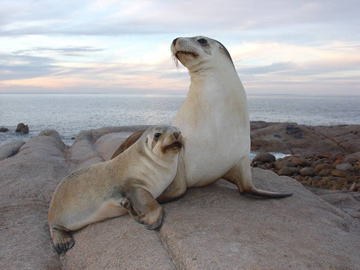Vulnerable Australian Sea Lions further threatened by gillnets and lobster pots
Vulnerable Australian sea lions further threatened by gillnets and lobster pots
Jeremy Hance, mongabay.com
November 26, 2007
The Australian Sea Lion inhabits only the coastal waters off south and west Australia. Historically, they were hunted almost to extinction by Europeans of the 18th and 19th centuries for their fur and oil. Beginning in 1895, certain populations of the marine mammal were placed under protection until the species gained national protection in 1975. These protections have yet to achieve their goal; Australian Sea Lion populations remain low with some subpopulations in decline. Due to these facts, Australia recently changed their conservation status to ‘threatened’.
The reasons for the population stagnation are not fully known. It has been proposed that infanticide, food shortages, and global warming could all play a role. However, the one cause where there is clear evidence is the large-scale fishing industry. Sea lions are vulnerable to bycatch; there are records of adult sea lions becoming entangled and drowned in gillnets while smaller sea lions have become trapped and drowned in pots used to catch rock lobster. Unfortunately, the numbers of sea lions killed as bycatch are unknown. Until now there had been no scientific studies of bycatch in the region, so the evidence is based primarily on anecdotes, interviews with fishermen, and studies in other marine areas.
 Australian Sea Lions, photo by Simon Goldsworthy |
To estimate the possible danger of bycatch to the Australian Sea Lion, Dr. Simon Goldsworthy and Dr. Brad Page compared the distribution of sea lion foraging with the distribution of the fisheries to locate the areas where sea lions and fishing operations overlap. Next, they measured the various sub-populations of sea lions to understand how much bycatch was needed to endanger the population. Finally, they studied different bycatch scenarios to find the subpopulations that were most at risk. Dr. Goldsworthy, a principle scientist for the South Australian Research & Development Institute (SARDI), describes the study as “hypothetical” since “at the time of writing it we had no independent observer data on bycatch rates”.
The findings showed that several of the sub-populations were at risk of extinction even if bycatch rates were relatively small. Already—without any future bycatch—24 percent of subpopulations were considered endangered. However with just 50 bycatches per year in gillnets that number could rise to 45 percent and with 200 bycatches it could rise to 92 percent. The numbers change a little with bycatch from the rock-lobster fishery since that industry only catches sea lion pups—50 bycatch equals 53 percent and 200 equals 82 percent. So, even a small amount of bycatch, say 50, would cause several subpopulations of sea lions to be at great risk of extinction. Dr. Goldsworthy noted that, “clearly many populations are endangered and critically endangered now… With 60 percent of populations producing fewer than 30 pups each breeding season, and some producing as few as 5 pups, some of these sites in the absence of any further fishery bycatch mortality may go extinct anyway.”
In light of this bleak picture, the Australian government is currently seeking solutions. Dr. Goldsworthy states his organization SARDI is “working closely with Commonwealth agencies (Department of Environment and Water Resources-DEWR, and the Australian Fisheries Management Authority -AFMA) to develop appropriate spatial management options that will deliver appropriate risk reduction to the Australian Sea Lion populations.” Of course, to accomplish the goal of minimizing bycatch of Australian Sea Lions, the various governmental organizations work closely with the fishing industry. Dr. Goldsworthy describes this as a first for the two fisheries. “The Southern Rock Lobster Fishery is being very supportive and proactive in developing the pot-protection measures,” Dr. Goldworthy says, referring to ‘seal spikes’ that can be attached to the rock lobster pots keeping sea lions and fur seals out. This change in gear has already proved a success in Western Australia. Unfortunately, the gillnetting fishery proves more difficult: unlike the rock lobster pots “there is no quick-fix to modify fishing gear”. Dr. Goldsworthy states that the only way to minimize bycatch then is through “spatial closures”—in other words lessening the amount of fishing done in sea lion areas—and that this will “directly impact” the industry, both in availability of fish and profit. Finally, fishing vessels for the first time have independent observers measuring the number of sea lion bycatches.
While the Australian government and the fisheries work together to mitigate the threat to the Australian Sea Lion, Dr. Goldsworthy states that “the public are not really aware of the issues or what is being done to resolve it”. The government and the fishing industry hope to solve the issue amicably without the public’s involvement.